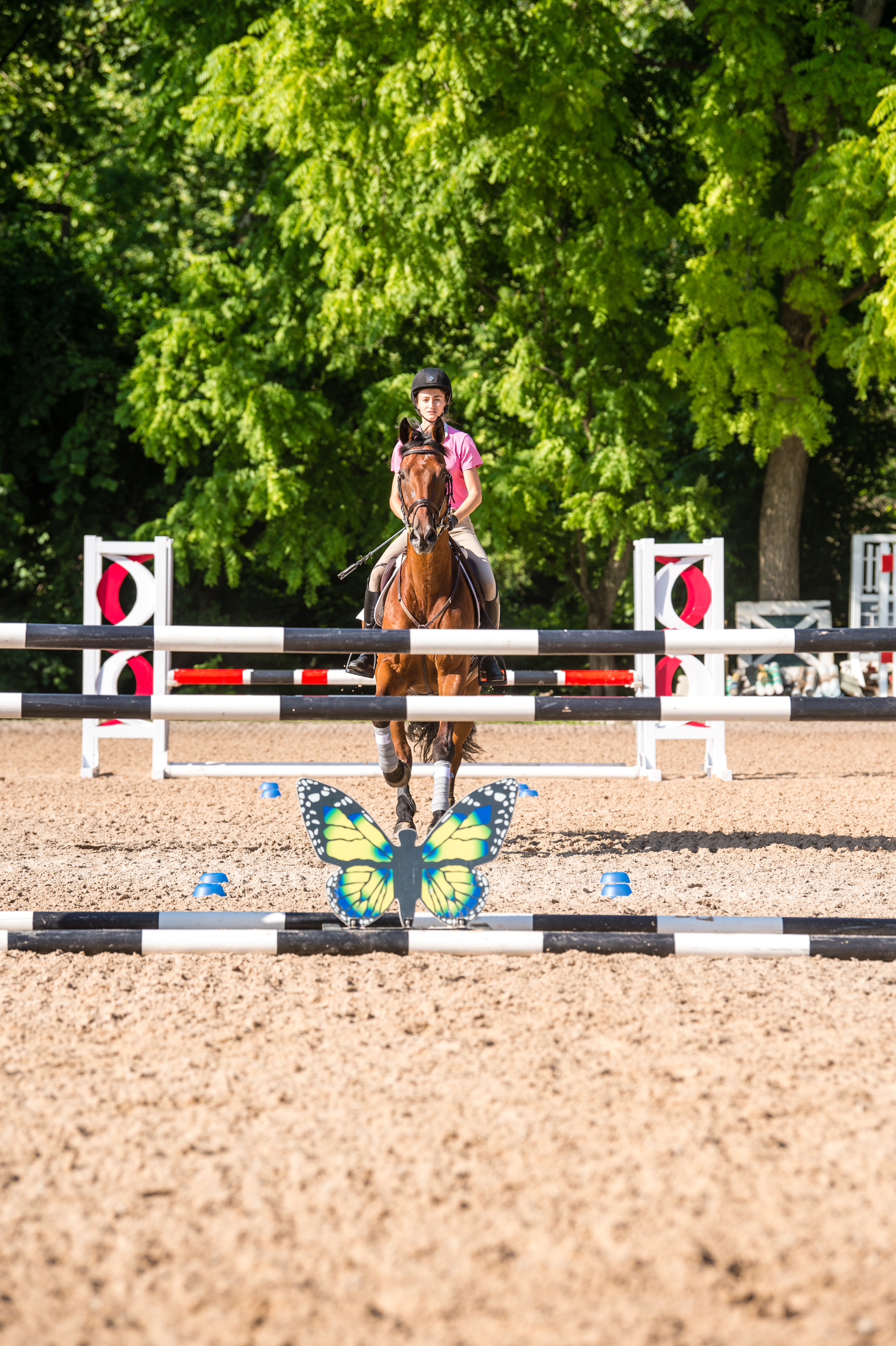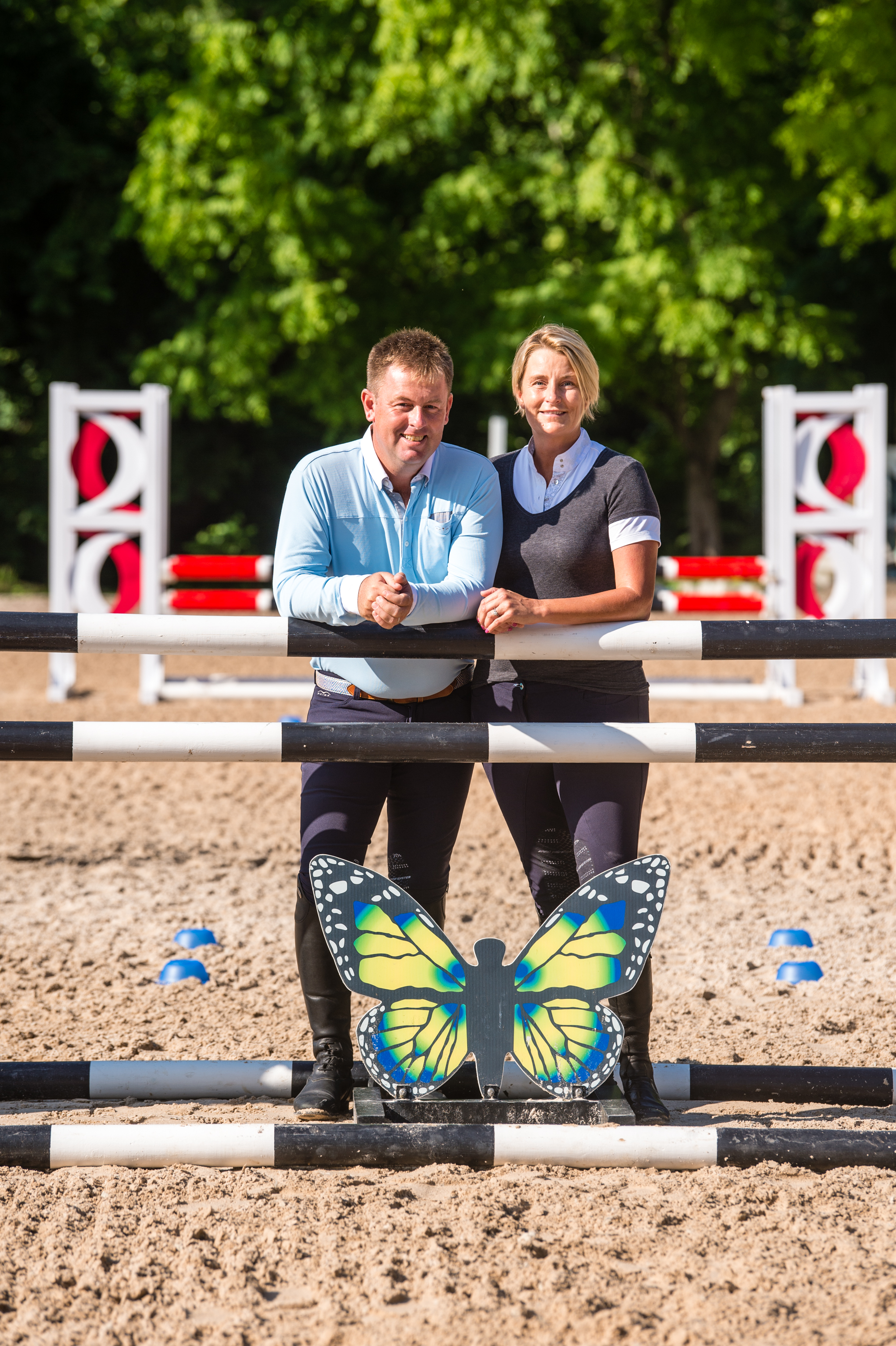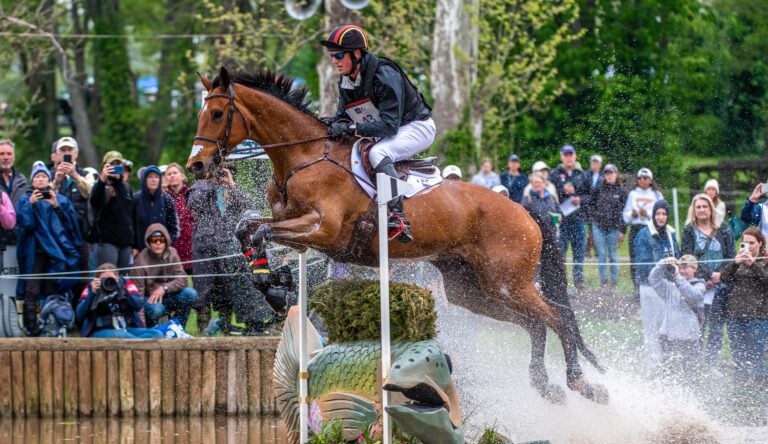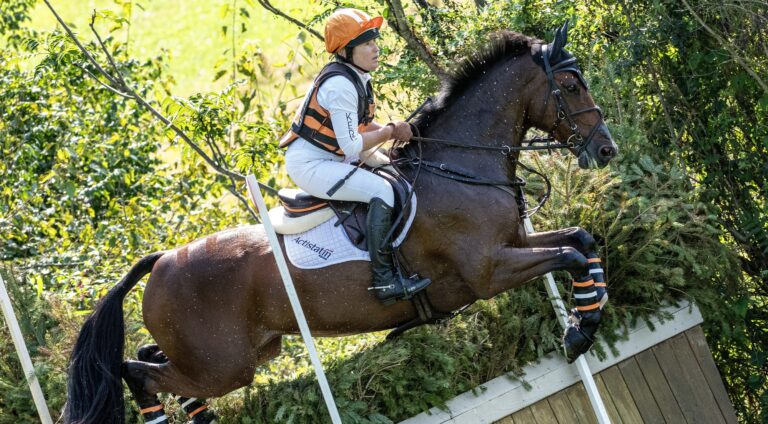
© Amy K. Dragoo
Many American eventers readily admit that stadium jumping is their weakest phase. Yet today’s medal winners—from countries like France, Germany and Great Britain—all look like they could walk into a jumper ring and not appear out of place. Some top U.S. eventers, such as 2018 World Equestrian Games competitors Lauren Kieffer and Will Coleman, are beautiful show jumpers, but as a whole, our skills are far behind those of other countries. It’s time we Americans take a look in the mirror and set the bar higher for ourselves.
One factor helping us to do this is the U.S. Equestrian Federation’s eventing show-jumping course advisor, Richard Jeffery. He’s pushing course designers around the country to raise their standards. Now as good as any in the world, our courses at all levels are very fair to the horses—not trapping them into making mistakes—but much more technical. There are twice as many related distances—jumps set on straight or bending lines with eight or fewer strides between them—than we used to see. So it’s easier to knock down lots of rails.
The Solution
Fortunately, we’re surrounded by jumper riders who know how to ride these courses. The U.S. has some of the world’s best grand prix riders. More eventers need to tap into the incredibly successful hunter/equitation system that produces them.
But wait, you’re thinking, event horses are different from hunters and jumpers. They have to be so bold on cross country; we don’t want them to become supersonically careful over their fences. True. But we can teach them to be more careful than they are now without diminishing their courage. To do so, though, we need to improve our own skills. When a horse hits a pole, he learns to jump more carefully next time only if he isn’t blaming the rider for getting in his way. Hunter/jumpers can teach us how to make that happen successfully.
See also: How can I discourage knockdowns?
Keep in mind: Eventers tend to overcomplicate things. Even at the four-star level, the jumps aren’t high enough to demand the extreme accuracy required of grand-prix riders, so you don’t need to learn all the subtle, sophisticated techniques they use. Instead, focus on mastering the fundamentals: Ride in a proper ring canter in rhythm and balance from the center of each jump to the center of the next one, get your “numbers” (the correct number of strides in related distances) and get out of your horse’s way. Here’s what you need to know to achieve all three of these goals.
Find Your Ring Canter
As good as eventers are at galloping across country, many ride around stadium courses too slowly and “backward” (with too much hand), often adding more strides in a line than a pure show jumper would. There’s a common misconception that a “slow clear” is better than risking having a rail down. In the past, timing was more erratic and the optimum time was often easy to achieve, but that’s no longer the case in today’s courses. You need to ride forward to make the time. And incurring four penalties for being four seconds slow is just as bad as four penalties for a rail down.
When we ask new students for a ring canter, nine out of 10 pick up either a long, lopey canter stuck in neutral or a canter with a 10- or 11-foot stride. Most of them just need to add 1 “mph” to the pace—they don’t need to be flying around the ring. A good ring canter is smooth and rhythmic, yet also adjustable. That’s where your dressage comes in. Strive to produce the same steady, flowing, harmonious picture in the show-jumping ring that you aim for in the dressage ring.
In competition, the first jump on course is usually a very forgiving shape, which means that you can ride to it with plenty of pace without worrying about knocking a rail down. So plan to start each round in your ring canter.
See also: How to pick the best pace for your courses
Ride Center to Center
On cross country, eventers rely a great deal on instinct. If a horse jumps too big or too quietly into a three-stride turning combination over two tables, we allow him to shift a little right or left off his line to make up the difference in the distance. Carrying this habit over into stadium jumping, however, can mean more rails down. To jump in his best-possible form, your horse needs to square his body to the fence so he can push off both hind legs evenly and power his body upward, not sideways. If he gets in the habit of shifting slightly right or left on takeoff, he’ll learn to lean onto one shoulder or the other or push more off one hind leg than the other. Allowing him to do this repeatedly at home teaches him that it’s OK to cheat in this way. Then, in competition, he won’t “sit down” correctly (rock his weight back onto his hindquarters on takeoff) and jump in a proper shape, so he’ll be more likely to have rails down.
If, on the other hand, you insist that he jump the center of each fence at home, he may knock rails down if he’s a bit lazy or hasn’t developed a correct jumping technique yet. But that will teach him to be more careful. Event riders worry too much about knocking down rails at home and in the warm-up. If you’re consistently doing everything else right, these knockdowns are a good reminder to your horse to polish up his jumping technique. This doesn’t happen overnight, though. Horses who are still learning the proper style often try different things before finally getting it right. For example, it may take three or four attempts on the same line. If your horse makes one mistake and knocks a rail down, he might make a different mistake the next time. The key is to give him the same ride each time until he figures it out.
For every stadium-jumping round, plan to ride a certain track, or line, from the center of each fence to the center of the next one. No matter what happens, don’t deviate from that plan! When a distance is a little too long or too tight—adjust your canter, not your line. We’ll explain how to do that next.
Get Your Numbers
The more accurately you ride each related distance, the closer you’ll get to ideal takeoff spots and the easier it will be for your horse to clear the jumps. Today’s course designers base these distances on a standard 12-foot stride, allowing about 6 feet each for takeoff and landing (depending on the height you’re jumping). That means that a one-stride will be 24 feet, a two-stride 36 feet, and so on, regardless of whether the jumps are on a straight or bending line. Everything makes sense; there’s no guesswork. If you practice measuring and walking lines at home based on these distances, then you can predict how many strides you should plan to ride in each line of a course. For more tips on walking lines accurately, see the “Measure Your Steps” below:
Measure Your Steps
To learn to walk lines accurately, use a measuring tape to mark a distance of 12 feet in your arena at home and teach yourself to cover 3 feet with each step so that you walk the measured distance in four steps—that’s one horse stride. When you walk your courses, stand at the landing side of the first jump of each line with your back to it and your heels against its base, then count your steps to the center and base of the next jump, noting the number of strides with each fourth step: “One, two, three, ONE [stride], one, two, three, TWO, one, two, three, THREE.” Subtract one stride to account for takeoff and landing.
Many other variables—such as a spooky jump, strange lighting, small arena (which can make horses feel claustrophobic and shorten their strides)—can influence how easily each distance rides in the expected number of strides. Over time, you will learn to anticipate some of these effects, but your primary job is simply to be prepared to react appropriately to any situation that changes how a distance is riding in that moment.
For example, if you arrive at the first jump of a five-stride line a little quietly, upon landing you need to close your leg and ask your horse to lengthen in the next stride or two so that the third, fourth and fifth strides can be normal. Ideally, he will even slow down slightly in the fifth stride, gathering himself to rock back onto his hindquarters for a quality jump. If you don’t address the distance problem early, you’ll still be squeezing your legs in those final strides to close the gap, which will make your horse jump flatter.
A similarly quick reaction is necessary if you see a long distance to the first jump. As soon as he lands, you must stretch up tall and “whoa” with both hands—never seesawing your reins, which will ruin your straightness and risk a runout—to collect the stride immediately so you won’t still be fighting to slow down on stride four or five, likely inviting a pole down. Great riders like two-time Olympic gold medalist Mark Todd get that done in a single stride so they can then be soft again, giving their horses every opportunity to jump the next fence in a good shape.
To respond to situations like this effectively, you need to develop your “eye”—your ability to adjust the stride as necessary to arrive at a good takeoff spot for each fence. Ignore people who tell you not to worry about distances. They’re either uneducated or so naturally talented that they don’t realize how effective their own timing skills are. If you don’t have that natural gift, don’t worry. You can train your eye. But you’ll have to practice, just the way musicians practice their scales. For more in-depth instruction on how to improve your timing, read Geoff Teall’s article, “See Your Distances,” in last month’s issue.
See also: The Importance of Knowing Your Horse’s Stride Length
Get Out of the Way
Nine out of 10 rails occur due to rider error, such as pulling on the reins in the approach, throwing your upper body forward on takeoff or otherwise interfering with your horse’s balance and concentration. In the approach to every jump, carry your hands—maintaining a straight line from your elbow to your hands to the bit—without allowing them to separate more than a few inches. Sit up tall with your upper body, giving your horse time to jump up to you. Then let go! Softening the rein contact on takeoff is crucial, giving him the freedom to use his body effectively. This is another critical skill carried over from dressage: Learning to execute a half-halt gives you the ability to let go.
Strengthening your lower leg is also invaluable, as that helps you to maintain your own balance in the air. Be aware, too, of how easily the weight of your head can throw your balance off. Momentarily looking up high to the sky before your horse lands can help you stay balanced so it’s easier to organize the moment his feet touch the ground. As you land, think, “Get back on my canter, then get straight on my line.”
One mistake that eventers often make is closing the legs on the takeoff for every jump. This is effective on cross country, where we want to rebalance and then ride forward to the jumps. But in show jumping, it can cause your horse to hit the rail with a front leg because you’ve pushed him forward rather than giving him time to jump up with his front end. For this reason, jumper riders often lighten their legs considerably on the takeoff at verticals or square oxers without much width.
Put It All Together
A good jumping instructor will cover all of these basics in every lesson, but you can also practice them in very simple cavalletti exercises. Set up two cavalletti or small jumps on a straight, six-stride (84-foot) line. To be sure that you’re truly riding from center to center, build chutes to ride through by adding a pair of ground poles or cones on the takeoff and landing sides of each cavalletti—about 10 feet away from it—parallel to one another and to the track. (To make the setup even simpler, you can build just two chutes: one on the landing side of the first jump and another on the takeoff side of the second jump.) Start with them quite wide—about a foot in from the ends of the cavalletti.
Canter back and forth over the cavalletti several times in six strides, always riding to the center of each one. Then try adjusting your stride to ride it in five, seven, eight, and if you’re more advanced, even nine or 10 strides, trying to keep the rhythm steady and never changing your line. Even when you have to adjust your striding within the line, always try to do so smoothly.
Meanwhile, concentrate on straightness, trying to take off and land on the same line every time. You’ll be surprised how hard it is to maintain this accuracy! As that improves, gradually bring the “chute” poles closer together (to no narrower than 4 feet apart).
When that’s going well, practice the same exercise on a bending line. Then put it all together: Ride the bending line to the straight line and vice versa.
Cavalletti are very low-impact exercises, so there’s no harm in doing them twice or even three times a week on good footing, in addition to your regular show-jump schools. Using them routinely is a great way to improve all the skills we’ve mentioned. It also helps to keep your horse “jumping fit”—strengthening the muscles he needs for jumping. Jumper barns almost always have one or two cavalletti exercises set up in their rings.
Remember, keep it simple and seek quality instruction. As your fundamentals improve, your jumping coach can help you finesse the rest of your competition strategy, for example, by creating a warm-up plan to suit your horse’s specific needs.
Finally, we highly recommend “practicing under pressure” at local hunter/jumper schooling shows. If you have a tight budget and/or schedule, consider replacing one of your planned events with a jumper show. This small investment will pay off with valuable clear rounds at future events.
Seek Quality Instruction
In eventing, many skills carry over from one phase to another, but to become truly competitive you must work with people who are good in each phase. If you don’t have the financial means or time to train with dressage and show-jumping instructors, make sure the eventing coach you select has a basic knowledge of all three phases and the competition results to back that up, both of students and personally.
Exercise 1: Straight Line with Chutes
To practice the skills needed for a successful stadium round, set a six-stride line and place a chute of markers on the landing side of the first jump and another on the takeoff side of the second. For less-experienced horses and riders, start with wider chutes than what is demonstrated in the photos below.


Natasha Erschen establishes a forward, rhythmic ring canter before turning her 16-year-old Irish Sporthorse, Fernhill Flutter (Butterfly), toward the line. Once straight to the first jump, she aims for its center.

In the air, she stays balanced over her feet and quiet in her body and hands, so Butterfly can focus on the job ahead of him.

As they canter straight through the middle of the first chute after landing, Natasha maintains a steady rein contact, but she still allows Butterfly to resume the forward ring canter that he had in the approach in order to produce six even strides.

To maintain his balance, she drops her weight into the saddle and brings her shoulders back. This allows her to soften the reins as they enter the next chute, perfectly set up to jump the center of the second fence.

Next, planning to ride the line in seven strides, Natasha approaches the first jump in a slightly more collected—yet still forward and rhythmic—canter. Once they jump the fence and exit the first chute, she will drop her weight into the saddle and half-halt, asking Butterfly to shorten his stride.

This allows her to add the seventh stride and still soften her contact as they enter the second chute. Once riding the line in seven strides feels good, she’ll try opening up Butterfly’s stride a little and canter the exercise in five strides.
Exercise 2: Bending Line to Straight Line
For this exercise, set a third fence on a six-stride bending line from the first jump of the straight line and add another chute of markers on its takeoff side.


Natasha approaches the first fence just as she did in Exercise 1: in a forward, rhythmic ring canter. In the air, she again stays balanced over her feet and quiet in her body and hands.

As they canter through the first chute, she turns her eyes to the left, planning the curved track to the next jump.

Following that track, she drops her weight into the saddle, asking Butterfly to maintain his rhythm and stride length. This brings them to the next chute in a good balance.

After jumping the second fence, she turns right and circles back to the second fence of the straight line she rode in Exercise 1, planning to ride it in the opposite direction.

In the air, Natasha and Butterfly are already focused on the final element of the exercise. As they land and canter through the first chute, Natasha will sink her weight down into the saddle, asking Butterfly to maintain his rhythm to …

… the next chute. As before, she stays connected to him with her seat and legs but softens her hands, allowing him to prepare for a good effort over the jump. After jumping the fence, she will bring him to a halt on a straight line and praise him.
About the Sara and Brian

International eventer Sara Kozumplik rode in her first Rolex Kentucky Three Day Event at age 20 on an off-the-track Thoroughbred named As You Like It. In 2009, she was named to the U.S. Eventing Team short list. Last year, she and Rubens D’ysieux finished second in the Bromont CCI*** and won both the $15,000 Ocala Horse Properties Eventing Prix, hosted by Southern Cross Equestrian, in Florida, and the inaugural $50,000 Arena Eventing class at the Devon Horse Show in Pennsylvania. A graduate “A” Pony Clubber and United States Eventing Association-certified instructor, Sara is a popular coach and clinician. She coached the Venezuelan event team at the 2013 Bolivarian Games in Lima, Peru, and the 2014 Central American Games in Veracruz, Mexico.
Brian Murphy, is an Irish show jumper who represented his country as a junior at the grand-prix level before moving to the U.S. in 2006. Now focusing on teaching, training and sales, he is known for his excellent “eye on the ground,” helping riders of multiple disciplines to improve their skills and become more competitive. Brian also gives clinics to students from across North America.
This article was originally published in the November 2018 issue of Practical Horseman.










